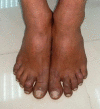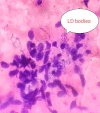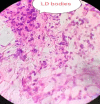A case report on para-kala-azar dermal leishmaniasis: an unresolved mystery
- PMID: 38110894
- PMCID: PMC10729440
- DOI: 10.1186/s12879-023-08918-1
A case report on para-kala-azar dermal leishmaniasis: an unresolved mystery
Abstract
Background: Post-kala-azar dermal leishmaniasis (PKDL) is a dermatosis that occurs 2-3 years after an apparently successful treatment of visceral leishmaniasis (VL). In rare cases, PKDL occurs concurrently with VL and is characterized by fever, splenomegaly, hepatomegaly or lymphadenopathy, and poor nutritional status and is known as Para-kala-azar dermal leishmaniasis (Para-KDL). Co-association of active VL in PKDL patients is documented in Africa, but very few case reports are found in South Asia. We present a case of Para-kala-azar Dermal Leishmaniasis (Para-KDL) in a 50-year-old male patient with a history of one primary Visceral Leishmaniasis (VL) and 2 times relapse of Visceral Leishmaniasis (VL). The patient presented with fever, skin lesions, and hepatosplenomegaly. Laboratory tests revealed LD bodies in the slit skin smear and splenic biopsy. The patient was treated with two cycles of Amphotericin B with Miltefosine in between cycles for 12 weeks to obtain full recovery.
Conclusion: This case report serves as a reminder that Para-kala-azar dermal leishmaniasis can develop as a consequence of prior visceral leishmaniasis episodes, even after apparently effective therapy. Since para-kala-azar is a source of infectious spread, endemics cannot be avoided unless it is effectively recognized and treated.
Keywords: PKDL; Para-kala-azar; Post-kala-azar dermal Leishmaniasis; VL; Visceral Leishmaniasis.
© 2023. The Author(s).
Conflict of interest statement
The authors declare no competing interests.
Figures





References
-
- Leishmaniasis -. PAHO/WHO | Pan American Health Organization. [cited 2023Mar10].
-
- Abadías-Granado I, Diago A, Cerro PA, Palma-Ruiz AM, Gilaberte Y. Cutaneous and mucocutaneous leishmaniasis. Actas Dermo-Sifiliográficas (English Edition). 2021. - PubMed
Publication types
MeSH terms
Substances
LinkOut - more resources
Full Text Sources
Research Materials

